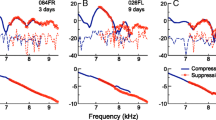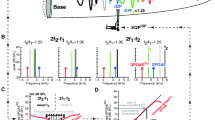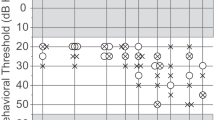Abstract
Physiological noise levels in the human ear canal often exceed naturally low levels of otoacoustic emissions (OAEs) near the threshold of hearing. Low-frequency noise, and electronic filtering to cope with it, has effectively limited the study of OAE to frequencies above about 500 Hz. Presently, a custom-built low-frequency acoustic probe was put to use in 21 normal-hearing human subjects (of 34 recruited). Distortion-product otoacoustic emission (DPOAE) was measured in the enclosed ear canal volume as the response to two simultaneously presented tones with frequencies f 1 and f 2. The stimulus–frequency ratio f 2/f 1 was varied systematically to find the “optimal” ratio evoking the largest level at 2 f 1−f 2 frequencies 87.9, 176, and 264 Hz. No reference data exist in this frequency region. Results show that DPOAE exists down to at least 87.9 Hz, maintaining the bell-shaped dependence on the f 2/f 1 ratio known from higher frequencies. Toward low frequencies, however, the bell broadens and the optimal ratio increases proportionally to the bandwidth of an auditory filter as defined by the equivalent rectangular bandwidth. The DPOAE phase rotates monotonously as a function of the stimulus ratio, and its slope trend supports the notion of a lack of scaling symmetry in the apex of the cochlea.








Similar content being viewed by others
References
Abdala C, Dhar S, Mishra S (2011) The breaking of cochlear scaling symmetry in human newborns and adults. J Acoust Soc Am 129(5):3104–3114
Arnold DJ, Lonsbury-Martin BL, Martin GK (1999) High-frequency hearing influences lower-frequency distortion-product otoacoustic emissions. Arch Otolaryngol Head Neck Surg 125(2):215–222
Bonfils P, Avan P, Londero A, Trotoux J, Narcy P (1991) Objective low-frequency audiometry by distortion-product acoustic emissions. Arch Otolaryngol Head Neck Surg 117(10):1167–1171
Christensen AT, Ordoñez R, Hammershøi D (2015a) Stimulus ratio dependence of lowfrequency distortion-product otoacoustic emissions in humans. J Acoust Soc Am 137(2):679–689
Christensen AT, Ordoñez, R, Hammershøi D (2015b) Avoiding spectral leakage in measurements of distortion-product otoacoustic emissions. Proceedings of Forum Acusticum 2014: European Acoustics Association, September, 2014
Christensen AT, Ordoñez, R, Hammershøi, D (2015c) Design of an Acoustic Probe to Measure Otoacoustic Emissions Below 0.5 kHz. 58th Audio Engineering Society International Conference: Music Induced Hearing Disorders, June, 2015, Aalborg Denmark, paper number 2–4
Cooper NP, Rhode W (1997) Mechanical responses to two-tone distortion products in the apical and basal turns of the mammalian cochlea. J Neurophysiol 78(1):261–270
Dhar S, Rogers A, Abdala C (2011) Breaking away: violation of distortion emission phase frequency invariance at low frequencies. J Acoust Soc Am 129(5):3115–3122
Dong W, Cooper NP (2006) An experimental study into the acousto-mechanical effects of invading the cochlea. J R Soc Interface 3(9):561–571
Glasberg BR, Moore BCJ (1990) Derivation of auditory filter shapes from notched-noise data. Hear Res 47(1):103–138
Gorga MP, Neely ST, Bergman BM, Beauchaine KL, Kaminski JR, Peters J, Jesteadt W (1993) Otoacoustic emissions from normal-hearing and hearing-impaired subjects: distortion product responses. J Acoust Soc Am 93(4):2050–2060
Gorga MP, Neely S, Bergman B, Beauchaine K, Kaminski J, Liu Z (1994) Towards understanding the limits of distortion product otoacoustic emission measurements. J Acoust Soc Am 96(3):1494–1500
Gorga MP, Neely S, Dierking D, Kopun J, Jolkowski K, Groenenboom K, Tan H, Stiegemann B (2007) Low-frequency and high-frequency cochlear nonlinearity in humans. J Acoust Soc Am 122(3):1671–1680
Gorga MP, Neely S, Dierking D, Kopun J, Jolkowski K, Groenenboom K, Tan H, Stiegemann B (2008) Low-frequency and high-frequency distortion product otoacoustic emission suppression in humans. J Acoust Soc Am 123(4):2172–2190
Greenwood D (1990) A cochlear frequency-position function for several species–29 years later. J Acoust Soc Am 87(6):2592–2605
Harris F (1990) Distortion-product otoacoustic emissions in humans with high frequency sensorineural hearing loss. J Speech Lang Hear Res 33:594–600
Harris F, Lonsbury-Martin BL, Stagner B, Coats A, Martin G (1989) Acoustic distortion products in humans: systematic changes in amplitude as a function of f 2-f 1 ratio. J Acoust Soc Am 85(1):220–229
Humphrey R (2007) Playrec: multi-channel matlab audio. URL http://www.playrec.co.uk
IEC:60318-4 (2010) Electroacoustics–simulators of human head and ear–part 4: occludedear simulator for the measurement of earphones coupled to the ear by means of ear inserts. International Electrotechnical Commission, Geneva
ISO:8253-1 (2010) Acoustics–audiometric test methods–part 1: pure-tone air and bone conduction audiometry. International Organization for Standardization, Geneva
Jurado C, Moore BCJ (2010) Frequency selectivity for frequencies below 100 hz: comparisons with mid-frequencies. J Acoust Soc Am 128(6):3585–3596
Kemp DT (1978) Stimulated acoustic emissions from within the human auditory system. J Acoust Soc Am 64(5):1386–1391
Kemp DT (1979) Evidence of mechanical nonlinearity and frequency selective wave amplification in the cochlea. Arch Otolaryngol Head Neck Surg 224(1–2):37–45
Kim DO (1980) Cochlear mechanics: implications of electrophysiological and acoustical observations. Hear Res 2(3):297–317
Lonsbury-Martin BL, Martin GK (2007) Distortion-product otoacoustic emissions in populations with normal hearing sensitivity. Ch. 5 in Otoacoustic Emissions Clinical Applications, Robinette MS, Glattke TJ (eds), 3rd Edittion, Thieme, New York.
Martin GK, Villasuso EI, Stagner BB, Lonsbury-Martin BL (2003) Suppression and enhancement of distortion-product otoacoustic emissions by interference tones above f 2. II. Findings in humans. Hear Res 177(1):111–122
Martin GK, Stagner BB, Fahey PF, Lonsbury-Martin BL (2009) Steep and shallow phase gradient distortion product otoacoustic emissions arising basal to the primary tones. J Acoust Soc Am 125(3):85
Martin GK, Stagner BB, Lonsbury-Martin BL (2010) Evidence for basal distortion-product otoacoustic emission components. J Acoust Soc Am 127(5):2955–2972
Martin GK, Stagner B, Lonsbury-Martin BL (2013) Time-domain demonstration of distributed distortion-product otoacoustic emission components. J Acoust Soc Am 134(1):342–355
Mauermann M, Uppenkamp S, van Hengel P, Kollmeier B (1999) Evidence for the distortion product frequency place as a source of distortion product otoacoustic emission (DPOAE) fine structure in humans. I. Fine structure and higher-order dpoae as a function of the frequency ratio f 2-f 1. J Acoust Soc Am 106(6):3473–3483
Nowotny M, Gummer AW (2006) Nanomechanics of the subtectorial space caused by electromechanics of cochlear outer hair cells. Proc Natl Acad Sci U S A 103(7):2120–2125
Probst R, Hauser R (1990) Distortion product otoacoustic emissions in normal and hearing impaired ears. Am J Otolaryng 11(4):236–243
Reichenbach T, Hudspeth AJ (2010) A ratchet mechanism for amplification in low frequency mammalian hearing. Proc Natl Acad Sci U S A 107(11):4973–4978
Reuter K, Hammershøi D (2006) Distortion product otoacoustic emission fine structure analysis of 50 normal-hearing humans. J Acoust Soc Am 120(1):270–279
Ruggero MA, Rich NC (1991) Furosemide alters organ of Corti mechanics: evidence for feedback of outer hair cells upon the basilar membrane. J Neurosci 11(4):1057–1067
Salt AN, Hullar TE (2010) Responses of the ear to low frequency sounds, infrasound and wind turbines. Hear Res 268(1–2):12–21
Shera CA, Guinan JJJ (1999) Evoked otoacoustic emissions arise by two fundamentally different mechanisms: a taxonomy for mammalian oaes. J Acoust Soc Am 105(2):782–798
Shera CA, Talmadge CL, Tubis A (2000) Interrelations among distortion-product phasegradient delays: their connection to scaling symmetry and its breaking. J Acoust Soc Am 108(6):2933–2948
Shera CA, Guinan JJJ, Oxenham A (2013) Otoacoustic estimation of cochlear tuning: validation in the chinchilla. J Assoc Res Otolaryngol 11(3):343–365
Stover LJ, Gorga MP, Neely ST, Montoya D (1996a) Toward optimizing the clinical utility of distortion product otoacoustic emission measurements. J Acoust Soc Am 100(2):956–967
Stover LJ, Neely ST, Gorga MP (1996b) Latency and multiple sources of distortion product otoacoustic emissions. J Acoust Soc Am 99(2):1016–1024
Talmadge CL, Long GR, Tubis A, Dhar S (1999) Experimental confirmation of the twosource interference model for the fine structure of distortion product otoacoustic emissions. J Acoust Soc Am 105(1):275–292
Zweig G, Shera CA (1995) The origin of periodicity in the spectrum of evoked otoacoustic emissions. J Acoust Soc Am 98(4):2018–2047
Acknowledgements
The authors would like to thank Claus Vestergaard Skipper for designing and implementing the preamplifier circuits and for helpful discussions in all aspects of the design of the acoustic probe used in the experiment. We give thanks to Sofus Birkedal Nielsen for important advice on the design of the preamplifier circuits. We also give special thanks to our subjects for making the first contact and patiently participating in the experiment for up to 2.5 h. The project was internally funded by Aalborg University.
Author information
Authors and Affiliations
Corresponding author
Additional information
Results were preliminarily presented at the Audio Engineering Society 58th International Conference: Music Induced Hearing Disorders, June 2015 and at the International Symposium on Auditory and Audiological Research, August 2015.
Rights and permissions
About this article
Cite this article
Christensen, A.T., Ordoñez, R. & Hammershøi, D. Distortion-Product Otoacoustic Emission Measured Below 300 Hz in Normal-Hearing Human Subjects. JARO 18, 197–208 (2017). https://doi.org/10.1007/s10162-016-0600-x
Received:
Accepted:
Published:
Issue Date:
DOI: https://doi.org/10.1007/s10162-016-0600-x




